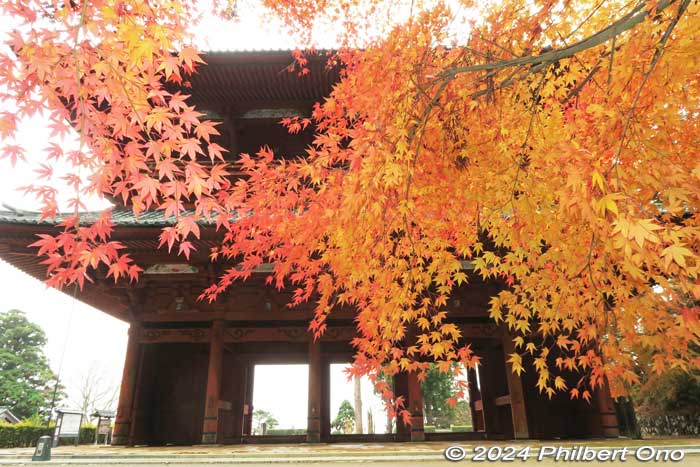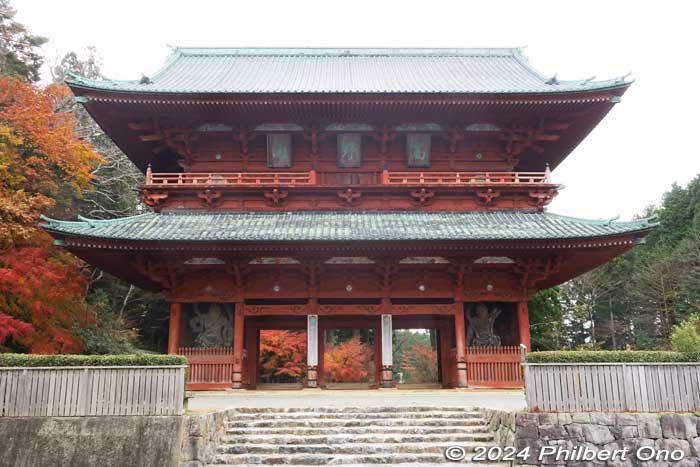
Wakayama Prefecture is most famous for Koya-san (Mt. Koya 高野山), the headquarters of the Shingon Buddhist sect founded by Kobo Daishi (Kukai); the Kumano Sanzan Shinto shrine trio (熊野三山) deifying three Kumano mountains; and the Kumano Kodo (熊野古道) ancient pilgrimage trails interconnecting Koya-san and all the Kumano Sanzan Shinto shrines.
Through Koya-san and Kumano Sanzan, the Kumano mountains have been a major cradle for both Shinto and Buddhism in Japan for over a thousand years. An incredible fusion of Buddhism and Shinto which later had to be separated.
From Wakayama, both the Shingon Buddhist sect and Kumano Shinto religion have since spread all over Japan and even overseas. Koya-san and Kumano Sanzan are also a World Heritage Site (Sacred Sites and Pilgrimage Routes in the Kii Mountain Range).
Today, Koya-san, Kumano Sanzan, and Kumano Kodo attract hordes of pilgrims and tourists. Since the sights are quite spread out, overtourism does not seem to be a problem.
Koya-san is in the mountains, but on flat terrain with numerous Buddhist temple complexes and smaller temples. It’s a busy temple town stretching along the main road from Daimon Gate to Oku-no-in Cemetery.

The massive Daimon Gate is the traditional entrance to Koya-san. It’s on the west end of Koya-san temple town. In autumn, it is flanked by many maple leaves. Built in the 11th century, the building itself is not open to the public.
https://www.koyasan.or.jp/en/meguru/sights.html#daimon

Although Koya-san is in the mountains, the populated area and temple complexes are on flat land. A substantial temple/tourist town has developed around Koya-san’s large and small temple complexes. Lots of traffic and tourists walking about. This location was especially chosen for its flat terrain surrounded by mountain peaks like being in the middle of a lotus flower surrounded by rising petals or mountain peaks.
Very different from Mt. Hiei (in Shiga Prefecture near Kyoto), another sacred, monastic mountain with Enryakuji Temple as the headquarters for the Tendai Buddhist sect. Enryakuji’s temple terrain is more mountainous and not really flat. It doesn’t have a temple town, so it’s much quieter and the sloping terrain is much more apparent. The temple town (Sakamoto) is instead at the foot of the mountain near the cable car station.
Koya-san: Danjo Garan temple complex

One major Koya-san temple complex and tourist attraction is Danjo Garan (壇上伽藍) with large temple buildings. Kondo Hall (金堂) is the main worship hall. Small admission charged. Danjo Garan is where priests study and train.

This complex hardly has any autumn foliage, but this vermillion Konpon Daito pagoda (根本大塔) brightens up the place. Admission charged to enter the main worship hall and this pagoda housing a large Buddha statue.

Danjo Garan also has this swank Fudodo Hall (不動堂), one of two buildings on Koya-san designated as a National Treasure. Used as a storehouse of temple treasures. Currently being renovated.
Danjo Garan location map: https://maps.app.goo.gl/bgfPVeaToY4W9YPp7

From Danjo Garan, just walk to Kongobuji Temple through a pleasant path lined with autumn leaves.
Koya-san: Kongobuji Temple

Kongobuji (金剛峯寺) is the headquarters temple of the Shingon Buddhist sect founded by Kobo Daishi (Kukai). It’s basically Shingon’s administrative center and where the top priest lives.
Photo above shows only the front entrance building (Ogenkan 大玄関) and only a part of a large complex of buildings behind it including a rock garden.
Pay the ¥1000 admission to go inside and see many rooms adorned with exquisite paintings on sliding doors, including paintings by Kano Tanyu (1602-1674) from the renown Kano school of Japanese painting famous for paintings on gold backgrounds. Interior photography not allowed except in the modern reception room.
https://www.koyasan.or.jp/kongobuji/jinai.html

Kongobuji map: https://maps.app.goo.gl/WC9SpYT9oeqVXxZM9
The next attraction is the Tokugawa Shogun Mausoleum, another short walk while passing by some red maples.




Tokugawa Shogun Mausoleums (徳川家霊台) for Hidetada (second Tokugawa Shogun) on the left and Ieyasu on the right at Koya-san. Built in 1643 side by side, almost identical. The colorful lacquer has long faded, and it’s a far cry from the Tokugawa mausoleums in Nikko, Tochigi. Only evergreens, no autumn foliage. Admission ¥200.

It’s popular to lodge at a temple (shukubo) to meditate and have religious, vegetarian cuisine (shojin ryori). I didn’t have time to do it, but I did have this vegetarian Koya-san shojin curry lunch (高野山 精進カレー) at the Koyasan Digital Museum‘s Cafe Shizuku. It was good and great to rest and warm up in the comfy cafe. Koya-san is in the mountains, so it can get quite cold in autumn. Dress warmly.
Koya-san: Kongo Sanmai-in Temple

Off the main road is a smaller temple complex called Kongo Sanmai-in (金剛三昧院). It’s a Shingon Buddhist temple worshipping Aizen-Myōō, one of the Wisdom kings.
The Tahoto pagoda is a major attraction. Commissioned by Lady Hojo Masako in 1223, the Tahoto is for the repose of her husband Minamoto Yoritomo (1147–1199) and son Sanetomo. It’s only one of two National Treasure buildings in Koya-san, so I had to see it. It’s Japan’s second oldest Tahoto pagoda after the Tahoto at Ishiyama-dera Temple in Otsu, Shiga Prefecture. Off the beaten path.
The Tahoto is beautiful, but it needs serious renovations. Wood is long faded, white paint peeling everywhere. Donations welcome.


Kongo Sanmai-in also has these huge wedded trees (fused at the roots) and smaller shrines like Shisho Myojin Honden Shrine which is a National Important Cultural Property. It might be more famous for the huge rhododendron bush growing as high as 10 meters. None of the buildings are open to the public unless you’re lodging there. The temple offers shukubo temple lodging. Small admission charged.
https://www.kongosanmaiin.or.jp/en/home
Kongo Sanmai-in map: https://maps.app.goo.gl/ukUE98rzf3b3kDgC8
My next stop was Oku-no-in which is a little too far to walk. So took a bus there.
Koya-san: Oku-no-in

Koya-san’s far end in the east has Oku-no-in (奥の院), basically a giant cemetery whose main attraction is Kobo Daishi’s mausoleum at the very end of the cemetery. Japan’s biggest cemetery with 200,000 graves. The cemetery got this large because many people wanted to be buried near Kobo Daishi.
There’s this long path going through it where you pass by all kinds of graves for all kinds of people (including famous samurai) and things. Amusing and amazing, if it’s not another form of advertising or corporate promotion.


Toward the rear of the cemetery near Kobo Daishi’s mausoleum, photography is not allowed. The mausoleum sees an endless stream of worshippers coming to pray. Sometimes a priest will come and chant. Lots of incense smoke.
https://www.koyasan.or.jp/en/meguru/sights.html#okunoin
Oku-no-in map: https://maps.app.goo.gl/yxyPmtbcjU44zq12A

It will take all day to see the sights on Koya-san. A day trip is possible, but lodging overnight in a temple would be ideal.
Getting to and around Koya-san
Getting to Koya-san is easy enough, but it requires a few transfers by train, cable car, and bus. The good news is that the transfers are usually timed well, so the waiting time for your next ride is minimal. The staff also kindly guides you to the next mode of transportation to make sure you make it on time.
- JR Hashimoto Station is the key gateway by train. You can get there from JR Wakayama Station (little over an hour) or Osaka (Shin-Imamiya Station), or Nara Station.
- From Hashimoto Station, ride the scenic Nankai Koya Line train to Gokurabashi Station (about 42 min.).
- From Gokurakubashi Station, the cable car takes you up the mountain slope to Koya-san Station (5 min.).
- At Koya-san Station, go to the bus ticket office and buy a bus pass (¥1100) for the day (or two) before boarding the bus. The bus pass also has discount coupons for tourist sights, gift shops, and restaurants in Koya-san. Well worth it. The station also has lockers.
- On the bus, most people get off at Oku-no-in first, then walk back toward Daimon Gate. But it’s up to you as to where to get off the bus in Koya-san. (I got off at Daimon Gate first, then walked toward the main part of town before taking the bus to Oku-no-in.)
- Buses run often enough within Koya-san and to/from Koya-san Station.
- More info: Getting there to Koya-san


Next: Visiting Kumano Sanzan